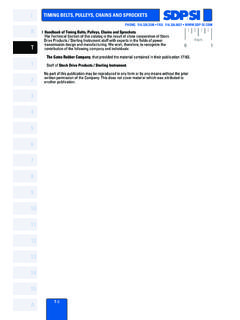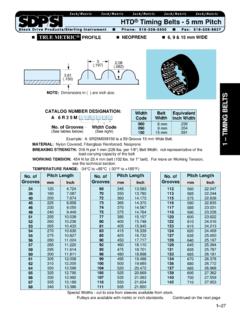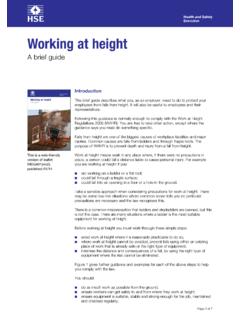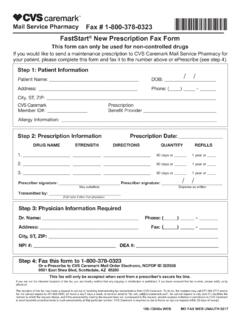Transcription of SECTION 24 TIMING BELT DRIVE SELECTION PROCEDURE …
1 T 146 SECTION 24 TIMING belt DRIVE SELECTION PROCEDUREStep 1 Determination of design loadDrives consist of a driver and a driven pulley. In general, both pulleys are not of the samesize; therefore, a speed reduction or increase occurs. Both convey the same power; however, thetorque on each pulley is different. DRIVE designs should be based on the smaller pulley which willbe subject to higher peak design load must be taken into account, and it is obtained by multiplying the torqueby a service factor.
2 Service factors between and are generally recommended whendesigning small pitch synchronous drives. Knowledge of DRIVE loading characteristics should influencethe actual value selected. A higher service factor should be selected for applications with highpeak loads, high operating speeds, unusually severe operating conditions, etc. Lower servicefactors can be used when the loading is smooth, well defined, etc. and the reliability is less designs may require service factors outside the to range, depending upon the natureof the a stall torque of the driver is not given but the nameplate horsepower or kW power consumptionis known, the torque can be obtained from.
3 X Shaft HPT (lb in) = (24-1) Shaft rpmT (lb in) = x T (N m) or (24-2)T (oz in) = 16 x T (lb in) (24-3)Tpeak = T x Service Factor (24-4)1 kW = HP (24-5) step 2 Choice of belt pitchAs shown in Figure 4, (page T-6) different belt pitches can satisfy the same horsepowerrequirements, also taking into account the speed of the faster shaft. The choice is somewhatindividual and may take into account, among others, the following factors: compatibility with previous designs superiority of GT drives as far as noise, backlash, positioning accuracy, etc.
4 Is concerned local availability for replacement size limitations; the size of pulleys and of the entire DRIVE will be optimized if GT2 orHTD pitches are usedStep 3 Check belt pitch SELECTION based on individual graphsGraphs shown on Figures 41 through 43 show the peak torque, Tpeak computed previously,plotted against the speed of faster shaft. Since the belt pitch was chosen in step 2, reference tothese graphs will confirm the validity of the an example, assume that the following data was obtained: T peak = 5 lb in and 1000 potential choices are: 2 mm GT2, 3 mm HTD, or XL.
5 The 2 mm DRIVE will be substantiallysmaller than the other 4 Determine speed ratioUse our Web site, , or DRIVE Ratio Tables shown in SECTION 21, starting atpage T-72, and establish the number of teeth of the small and large pulley based on the chosenspeed ratio. Attempt to use available stock sizes for best economy. Use of our Web site willimmediately guide you to the appropriate catalog page and part number. Make note of the PitchDiameter (PD) of the small SECTIONT 147 belt Technical Information 1 2 3 4 5 7 10 20 30 40 50 70 100 200 300 400 500 (lb in) 11 23 34 45 57 (N m)14,00012,00010,0009,0008,0007,0006,000 5,0004,0003,0002,0001,000900800700600500 400300200100rpm of Faster ShaftDesign Torque (Tpeak)Fig.
6 41 GT2 belt SELECTION Guide2 mm GT23 mm GT25 mm GT2 TECHNICAL SECTIONT 148 Fig. 42 HTD belt SELECTION Guide0 50 100 150 200 250 300 350 (lb in) 11 17 23 28 34 40 (N m)rpm of Faster Shaft30,00020,00010,0008,0006,0005,0004, 0003,0002,0001,0008006005004003002001003 ,450 rpm1,750 rpm1,160 rpm870 rpm3 mm HTD5 mm HTDD esign Torque (Tpeak)
7 belt Technical InformationTECHNICAL SECTIONT 149 TECHNICAL SECTION Fig. 43 Trapezoidal belt SELECTION Guide0 2 4 6 8 10 12 14 (lb in) 32 64 96 128 160 192 224 (oz in) (N m)
8 Rpm of Faster Shaft30,00020,00010,0008,0006,0005,0004, 0003,0002,0001,0008006005004003002001003 ,450 rpm1,750 rpm1,160 rpm870 rpmXL (.200")Design Torque (Tpeak) belt Technical InformationMXL + 40 (.080" & .0816")T 150 step 5 Check belt speedBelt speeds up to 6,500 fpm ( m/s) do not require special pulleys. Speeds higher thanthese require special pulley materials and dynamic is computed using the following equations:V(fpm) = x pulley PD (in) x pulley rpm (24-5)V(m/s) = x pulley PD (mm) x pulley rpm (24-6)where: m/s = x fpm (24-7) step 6 Determine belt lengthThe design layout may govern the determination of the belt length.
9 Since the pulley sizes areknown, use of Center Distance Factor Tables shown in SECTION 23 (starting on page T-81) willyield NB the number of teeth of the belt . If a fractional number is obtained, the closest integernumber should be chosen, and the calculation must be repeated to obtain the new center distancefor the is worthwhile to check if a belt with the chosen number of teeth is available in this it is not available, the closest fitting belt size must be chosen, and the calculation must berepeated to establish the center distance to which the layout must be corrected to accommodatethe available choice of 7 Determine the belt widthThe number of grooves of the small pulley as well as the rpm of the faster shaft on which thispulley is located are known.
10 Tables 43 through 52 show the torque and/or horsepower or kilowattratings for the base width of particular belt the HTD and GT2 drives, the torque ratings shown in these tables must be multiplied bythe length correction factor. This factor is a number smaller than 1 for shorter length and higher forlonger belts. This reflects the fact that a longer belt will be less prone to wear and tear as opposedto a shorter the given torque from the table is multiplied by the length correction factor, this figuremay be smaller or larger than the previously computed peak torque Tpeak.















